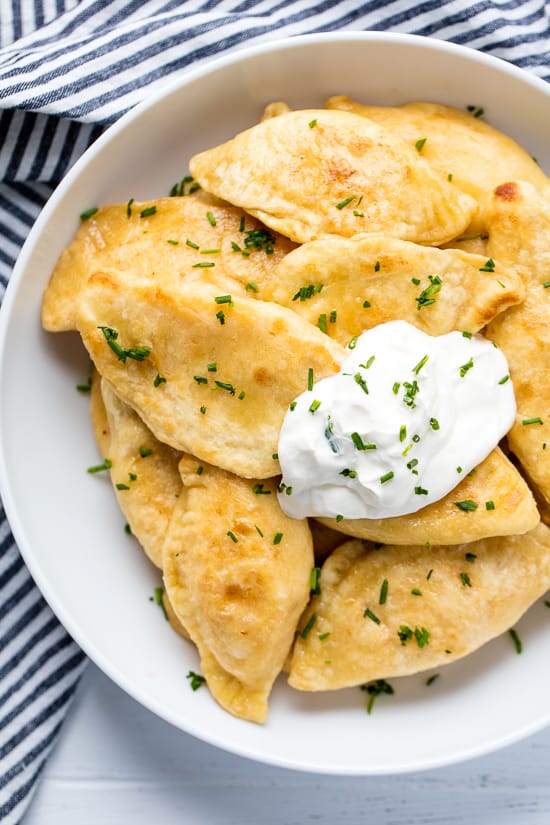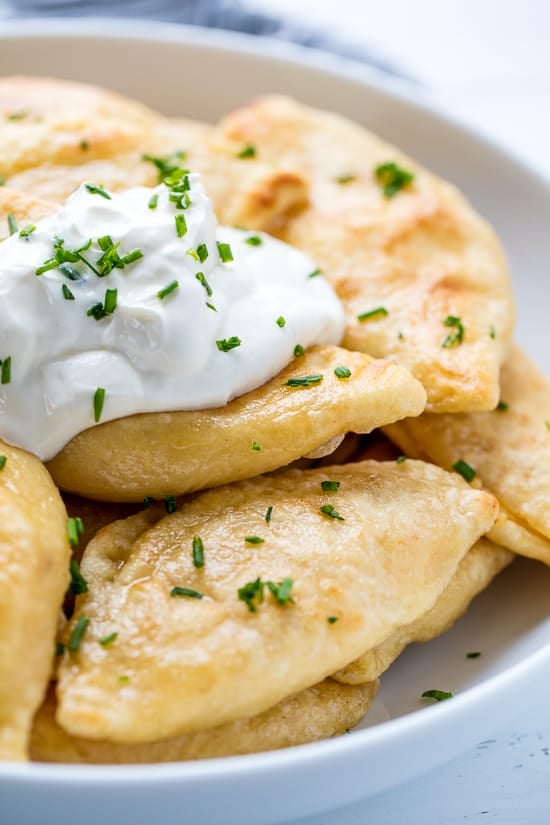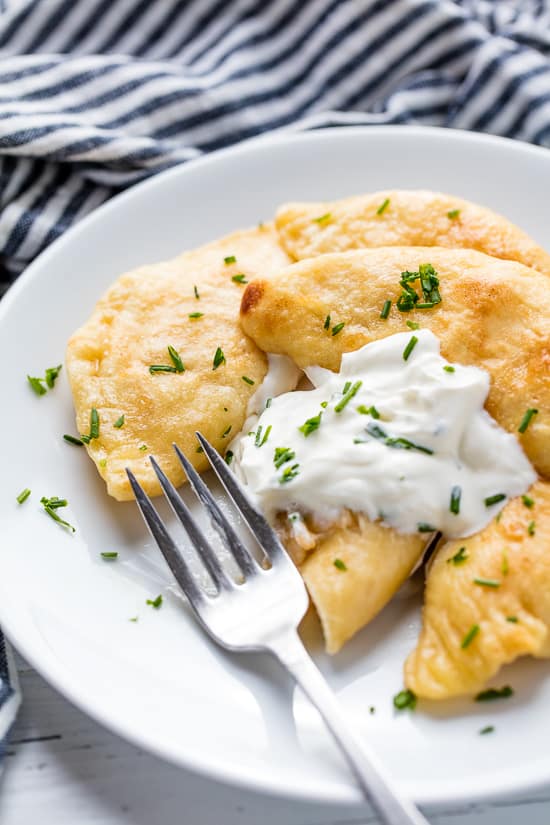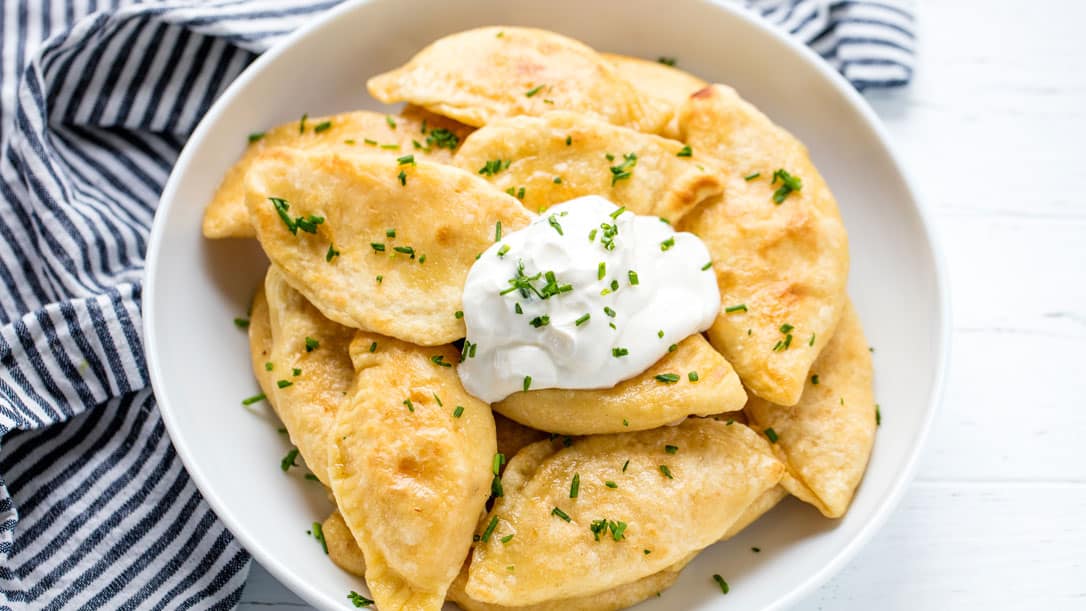Homemade Pierogi are stuffed with a flavorful potato and cheese mixture, boiled, and fried up in melted butter for a delicious, indulgent, total comfort food dinner.

Pierogies are a classic Polish comfort food dish. In this recipe I’ve taken all of the elements of a classic pierogi and simplified them for the average home cook. While this dish takes time to make, it is overall fairly simple. A quick homemade dough requires some rolling out which is where most of your time will be spent, but it’s fairly simple and a good item to make with children, or as a family. Many hands make light work.
Pierogi can be filled with various fillings, but tradition is a potato and cheese curd mixture. In this recipe we use mashed potatoes and cheddar cheese. Feel free to experiment and use your favorite cheese. Leftover mashed potatoes work really well in this recipe, but you can always make them from scratch specifically for filling. Most grocery stores carry frozen or refrigerated mashed potatoes or you can buy them at the deli counter if you are short on time.

What is good to eat with pierogies?
A simple, traditional topping is simple sour cream and maybe some chopped chives. You can also serve pierogies up topped with caramelized onions, paprika, fried sage, or Polish sausage.
What kind of sauce goes on pierogies?
For classic potato filled pierogi, a simple sauce of melted or browned butter is the sauce of choice. If you choose other filling options in your pierogi, like spinach, a light garlic yogurt sauce pairs well.
What do you serve with pierogies?
Roasted vegetables are always a great option to serve with pierogies. You could try some roasted broccoli or serve them up with some roasted simple honey roasted brussel sprouts. You also can’t go wrong with some simple green beans.

Can I freeze these?
Yes! You can freeze these pierogies after they have been assembled. And boil them from frozen when you are ready to eat. To freeze, simply place your pierogies in a single layer on a parchment lined baking sheet. Make sure they aren’t touching so that they don’t stick together. Once frozen, remove from the freezer and transfer to a resealable plastic bag for long term storage.
PRO TIP: The key to homemade pierogi is to be sure to seal it shut so that none of the stuffing comes out during cooking. Don’t let any of the filling get in between the dough edges or you won’t be able to get a good seal. Pinch the dough shut with your fingers and then press with the tongs of a fork to further seal and give a decorative edge.
Watch the video below where I walk you through every step of this recipe. Sometimes it helps to have a visual and I’ve got you covered, including how to roll, stuff, and seal your pierogi. You can find my full collection of video recipes on YouTube.


Just made the dough, it’s resting. Potatoes made. Will be a perfect side for baked Easter ham! And I’m making your best ever dinner rolls too. In the 1st dough risking stage now! Thank you for the awesome recipes, Rachel! Happy Easter!
In my opinion sour cream makes a difference in texture and taste. There are many variations but kudos to you Rachel for your recipes and instructive videos..!
Does anyone know if this recipe will work with sweet potatoe ?
I Follow a Lot Of Recipe and you make so Simple and Delicious
I live in central Canada and there is a large population of Ukrainian, Polish as well as Mennonite Germans. I am part Icelandic and Scottish – but we had pirogies at every holiday dinner – potato and cheese! We would gather and make a huge pile of them.
Love this recipe and may have to pause the low carb meals for a bit and have a treat!
I love Pierogies. I first tasted them in an Polish restaurant In Toronto and fell in love. I buy the frozen varieties in the grocery store. But I am so grateful to Rachel for showing us an easy, and I, sure a delicious, homemade version of these wonderful Pierogies. I will put aside an afternoon to make a large batch of these to be frozen for an easy side for future dinners.
Looks fantastic. Will have to try this.
I made this perogie recipe for the first time. Actually first time ever making perogies. The dough was fantastic to work with, nice and stretchy, sealed very well as not one opened up when boiled. I took some advice from one of the replies and added two cloves of garlic to my filling. I think one would have been plenty or maybe should have roasted the garlic as it was very strong . ( which I didn’t mind but I know others would have complained).
I found after I started eating them and they began to cool off the dough got tough and did not keep its soft texture which I did not like., as I enjoy late night leftover cold perogie raids on the fridge. I believe the eggs made them tough when cold. Any thoughts on what perogie dough would be better for soft tender dough?
Thanks the recipe was good though!
I use only one egg and actually some recipes are made without egg. I was introduced to Perogis 45 years ago when I met my husband with Russian parents. Female church members use to make 100’s for an after mass luncheon. All varieties were offered, pot or farmers cheese, saurekraut, fruit and other types of meat. Similar to a Coney Island Knish, they are good in any shape with any sort of filling. Of course, my mother-in-law made them frequently at home and I enjoyed the potato and cheese version boiled and then sauted in sweet onions served with sour cream because I am Irish. Yum For a Knish recipe try Chef John on the Food Network. I am anxious to try his corn beef, potato and cabbage Knish.
If using flour to prevent the sticking dust it off by picking it up a giving it a shake or after rolling take a large new paint brush and brush off access and wet very lightly with a spray bottle this way the flour cooks in with the filling and it will stay stuck together around the edges better also. Extra work but worth it.
No lay them apart on a sheet pan I find that a piece of parchment paper is good to use in the sheet pan . Freeze until solid then transfer to freezer bag. Pull them out as you need. Boil then fry.
Baba always used a clean dish towel instead, when freezing them, peel right off…
Can anyone tell me if you want to freeze the pierogis, do you boil them first?
Freeze before boiling.
Boil and rub using a stick of butter over each one so they don’t stick together then freeze in plastic freezer bags. Been doing this for over 55 years.
I do not. Freeze raw and then boil as many as you wish. Then fry if you like them that way. I love mine just boiled with butter and cooked onions over top.